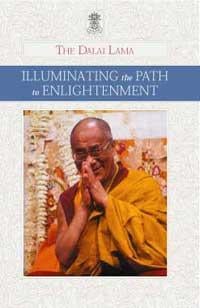We at Thubten Dhargye Ling are very happy for the opportunity to present His Holiness the Dalai Lama’s lamrim teachings in book form. Due to changing times and circumstances, more and more people in the West are taking a serious interest in Buddhism, or Dharma. It is for this reason that when His Holiness visited Los Angeles in 1997 to teach on Nagarjuna’s Precious Garland, I requested that he return in 2000 to give a teaching on the lamrim. His Holiness accepted this request very happily. I did not ask for His Holiness to teach a specific lamrim text, but out of his deep insight and altruism, he decided to combine two lamrim texts—Atisha’s Lamp for the Path to Enlightenment and Lama Tsongkhapa’s concise lamrim, Lines of Experience.
Buddhism originated from its founding teacher, Shakyamuni Buddha, who gave 84,000 forms of teaching. Lamrim means “stages of the path to enlightenment.” It was the great Indian master, Atisha, who wrote the first lamrim text, Lamp for the Path to Enlightenment, which condenses all 84,000 teachings into a single body of work. Atisha wrote this text in Tibet at the request of a Tibetan king. He then sent the text to India, where all the great realized scholars and mahasiddhas received it with praise and appreciation. It must be due to the good fortune and merit of the Tibetan people, they said, that Atisha had composed such a wonderful text.
Atisha’s lamrim text is very brief but extremely profound, and Lama Tsongkhapa knew that without some further explanation, many people would not be able to understand everything that it contained. Taking Atisha’s lamrim as the root text, Lama Tsongkhapa elucidated the teachings in three different versions: the Great Lamrim, the Middling Lamrim and the Short Lamrim.
I believe that His Holiness the Dalai Lama has very deep reasons for giving these lamrim teachings. Many of us wish to practice the tantric path with the sincere hope of achieving complete enlightenment as soon as possible. For us to become completely enlightened through the practice of tantra, however, there are some essential preliminaries that we need to practice first. To be truly qualified to practice tantra, we need to cultivate the three principal paths—renunciation, bodhicitta (the altruistic mind of enlightenment) and the wisdom realizing emptiness. The lamrim teachings cover all these subjects in great detail.
If we cannot achieve realization of these paths before engaging in tantra, we should at least have familiarized our mind with them and gained some experience in their practice. In this respect, the lamrim teachings are indispensable guides. We find explanations of the three principal paths throughout all the Buddha’s teachings but what the lamrim does is to present them in a manner that is relatively easy to comprehend and practice.
Whenever His Holiness the Dalai Lama gives a public teaching, he p resents the text in a ve ry skillful way that meets the needs of people and practitioners at all levels. This lamrim teaching is no exception. It is my belief that by reading the profound yet easy to follow commentary in this publication, many practitioners will receive tremendous benefit. Because of the depth of His Holiness the Dalai Lama’s spiritual experiences and realizations, as well as his skillful methods and infinite compassion and wisdom, his teachings are unsurpassed by any other. In order to preserve these invaluable teachings, not only for the present generation but for all future ones, we at Thubten Dhargye Ling are making every effort to ensure that they are a vailable to the public in the form of videotapes, audiotapes and books.
I would very much like to encourage readers to read this lamrim commentary over and over again. With each reading and contemplation, you will gain deeper insight into these teachings and find better ways to apply them to your own mental development. In Buddhism, we talk about cultivating three types of wisdom; those arising through listening to teachings, contemplating their meaning and meditating on the ascertained meaning.
These three types of wisdom have to arise sequentially in our mind stream. Through listening to teachings, we gain understanding; through contemplation, we deepen this understanding; through meditation, we apply the teachings to ourselves—in other words, we engage in the practice. We are very fortunate to have this wonderful human life and the opportunity to study and practice these teachings. We should make our best efforts , therefore, to follow the Dharma so that we will experience the benefits not only in this lifetime but also in many future lifetimes—and not just for ourselves but for other sentient beings as well.
We at Thubten Dhargye Ling hope that through contemplating and meditating on these teachings, readers will gain great spiritual benefit. We hope that this publication will facilitate greater intimacy with the three principal paths of renunciation, altruism and the wisdom of emptiness. May we all be able to cultivate these paths within our own minds.
We dedicate the virtue arising from this publication to the long life of His Holiness the Dalai Lama and all other great spiritual masters who uphold the pure teachings of the Buddha for the benefit of others.
May this world be free of sickness, starvation, warfare and weapons of mass destruction. May we all be able to accumulate the necessary facilities for our own well-being and for the attainment of peace in the world, and may we develop the ability to extend our affection and love beyond ourselves so that we can all learn to help and care for one another better.
—Geshe Tsultim Gyeltsen
Spiritual Master and Director
Thubten Dhargye Ling, Tibetan Monastery
Long Beach, California, USA































